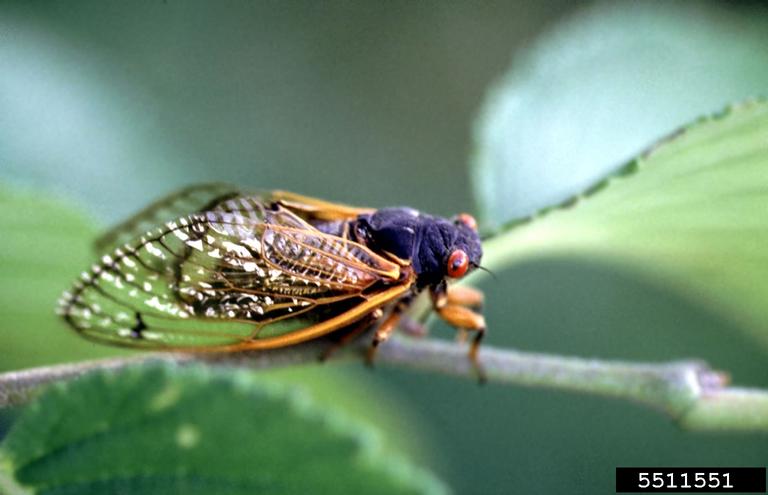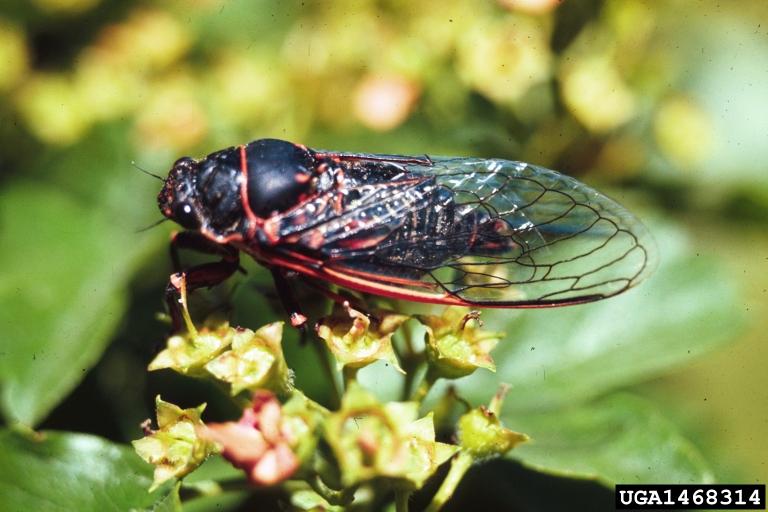
There are several bug species that can infest your landscape this year, especially once summer rolls around. But why wait? Why not start preparing yourself and your plants for what’s to come?
In this article, we give you insight into 3 bugs you can expect to find this year (spoiler: two are invasive and one will be hard to miss!).
#1: Emerald Ash Borer
Expect to see them emerge in mid to late May
What is Emerald Ash Borer (EAB)?
- Invasive tree bug
- Bright green
- Smaller than a dime
- Infected trees have a 99% mortality rate
- Affected trees usually require expert treatment to stay alive
In 2002, Emerald Ash Borers (EAB) were accidentally imported from Asia into Detroit. Since then, they have taken a toll on Ash trees all across the United States. In fact, Emerald Ash Borers have killed ~30,000 trees within the years 2013 to 2017 alone.
Yet, this statistic isn’t too surprising given the alarming impacts they leave on Ash trees. When trees are hit with this tree bug, the tree will likely die within 3 years – a fact that might concern you and other homeowners.
Why is this? Emerald Ash Borers like to feed on the tree’s vital tissues which reduces the tree’s ability to transport water and nutrients. The tree experiences dehydration, malnourishment, dieback, and bark splitting, which altogether is likely to result in tree mortality.
Signs/Symptoms:
- Canopy dieback, beginning at the top and progressing downward
- In later stages, Ash trees may form sprouts from the trunk and roots
- Increased woodpecker activity
- The tree’s bark can split, exposing “S”- shaped galleries underneath
- “D” Shaped exit holes in the tree’s bark about 1/8 inch in diameter
Treatment:
Trees infested with Emerald Ash Borers are unable to recover without treatment. Whether you are looking to take preventative steps or your tree ends up becoming damaged by EAB, as a tree preservation company, we will help you do what it takes to save your tree.
Our Emerald Ash Borer Protection Program:
- Provides protection for 2 years
- Is applied through soil injection or trunk injection, depending on the location of your tree
- Is safe for the tree, humans, animals, and the general surrounding environment including other trees and plants.
However, EAB infestations can reach a point of no return. If the invasive tree bug has invaded too much of the tree, it will severely weaken the structure of the tree and may put you and your property at harm. At this stage, you will need help with professional tree removal; our tree experts are here to help you with that.
Verdict: Highly dangerous invasive tree bug that is commonly found in Virginia. Is extremely likely to kill your Ash tree. Be wary and on the lookout for them so you can help your trees before it’s too late.
>> Learn more about Emerald Ash Borer and how it can be a death sentence for your tree
#2: Spotted Lanternfly
Expect to see them emerge around April–May

What is Spotted Lanternfly?
- Invasive tree bug
- Actually a planthopper (not a fly!)
- Appearance varies drastically, depending on their stage in the lifecycle
- Very new to the United States and DC Metro area
- Weakens plants and can attract additional stressors such as other bugs, diseases, and fungi
Spotted Lanternflies have only been in the DC Metro Area since 2018, but have been known to leave a nasty, sticky, and harmful aftermath to crops, trees, and ornamentals. They mainly like to target Ailanthus (Tree of Heaven), an invasive tree species, but can attack a large range of crops and plants including: grapes, apples, stone fruits, pines, maples, willows, poplars.
The good news about Spotted Lanternflies is they won’t sting or bite you or your pets; the bad news is, they can infiltrate your landscape and damage the plants they touch, namely by sucking up important nutrients and leaving behind sticky honeydew.
How do Spotted Lanternflies damage trees and other plants? Spotted Lanternflies practically steal important nutrients from the plant for their own survival. Not only does this malnourish the tree, but it also leaves a sticky, sugary honeydew behind that creates even more tree or plant damage.
The honeydew is similar to the sap left by aphids, but somehow far more plentiful. It facilitates the growth of sooty mold, attracting other potentially harmful tree bugs, and thus continuing the cycle of pest infestation and tree damage.
Signs/Symptoms:
- Weeping wounds/dark streaks down the bark of the tree
- A sap-like substance at the base of the tree
- Black fungus at the base of the tree (sooty mold)
- Increased bee, ant, and wasp activity
- Eggs, Nymphs, or Adult insects on the tree
- Leaves wilting or curling
Treatment:
If you start to notice signs of the tree bugs this spring, schedule an appointment with one of our Certified Arborists. Our tree experts will be able to develop a plan customized to your landscape that can help prevent and protect your plants from Spotted Lanternflies.
Verdict: Invasive tree bug that can cause great harm to your plants. To protect your trees and other plants, watch out for the invasive species and reach out to us if you need help.
>> Learn more about this new invasive tree bug
#3: Cicada Brood X
Expect to see them emerge mid-May
What is Cicada Brood X?
- Is not an invasive species, but is periodical, in other words it…
- Comes out every 17 years
- Is the largest ranging of all the cicada cycles in the United States
- Fast-moving, black, orange, and red tree bug
- Swarms the DC Metro area more than other periodical broods
If you remember dealing with a mob of cicadas that hit the Northern Virginia, DC Metro area back in 2004, chances are you’ll remember it this year as well; they’re from the same brood! Cicada Brood X is known to be the largest ranging of all the broods that hits our area.
But, unlike the previously mentioned tree bugs in this list, when it comes to periodical Cicadas, damage doesn’t come from feeding but rather from egg-laying.
What damages do Cicadas leave? Due to their egg-laying habits, female cicadas can create cosmetic issues which often worry homeowners. Branch ends often break and/or tree leaves may wilt. Overall, however, little damage is left on plants – especially when it comes to mature, older trees. Unlike younger trees and ornamentals, older trees are more established and can easily recover from the damages Cicadas leave behind.
Signs/Symptoms:
- Weakened branches
- Loss of branch tips
- Tree branch flagging
Treatment:
If you do have younger trees or ornamental fruit trees, it’ll be best to stay on the preventative side to protect them from any damage.
To help protect your younger trees or ornamentals against cicada infestations, we recommend netting.
Netting:
- Can be found at most home improvement stores or garden centers
- Prevents most Cicadas from being able to climb the small tree or shrub
Verdict: Harmless, but can be annoying. Listen for the chirping sound at night! Watch your steps to avoid crunching. And enjoy the brood while they’re here! Good luck out there.
If you have any questions or concerns in the upcoming months regarding these tree bugs, you can call us at 703-573-3029 or reserve an appointment online to meet with one of our Certified Arborists.







